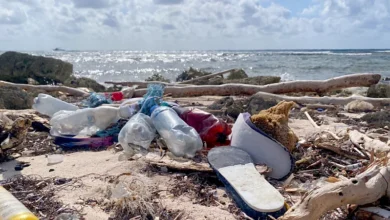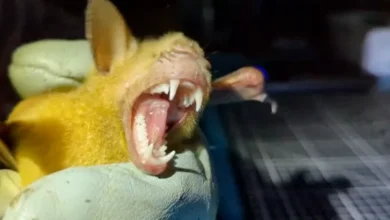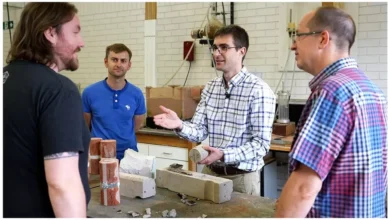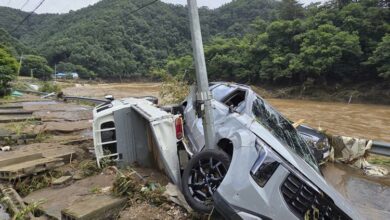The photos showing why pink dolphins are the Amazon’s ‘great thieves’
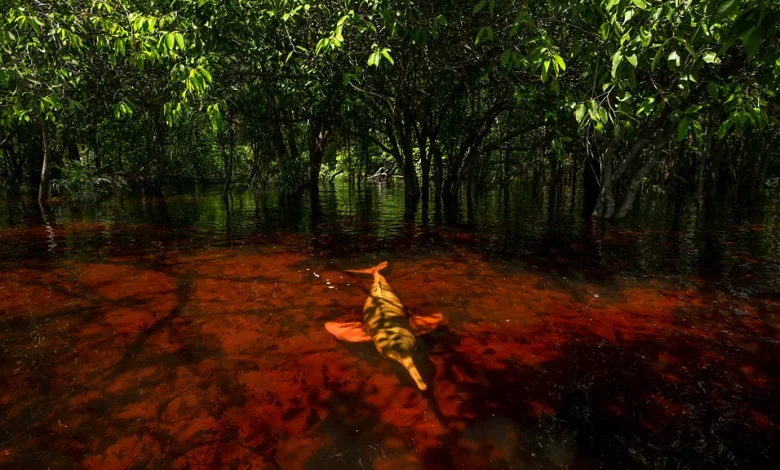
Dramatic underwater photos capture the elusive Amazonian pink dolphins red-handed.
In 2023, as the Sun was about to set, photographer Thomas Peschak entered the black waters of the Rio Negro River in the Brazilian Amazon. With his camera in hand, he waited for the perfect moment to catch a thief in the act. As fishermen cast their nets into the river, suddenly a sleek pink shape emerged from the depths, swimming toward the trapped fish. Peschak held his breath underwater and started shooting. Moving quickly, the creature – an Amazonian pink river dolphin – poked holes in the net and stole a catfish.
“They are very agile and can manoeuvre with incredible exquisiteness around these nets underwater,” Peschak says. “They are great thieves!”
At the time, Peschak knew he was documenting something no one else had managed to capture on camera. These dolphins have learned to associate the nets and the sounds of fishing boats with an easy meal. Peschak is the first photographer to document this behaviour underwater.
The lack of precise information on where to find these animals and the poor visibility in the muddy waters of the Amazonian rivers were major challenges, he says. But Peschak, who has worked as a marine photographer for over 20 years, drew on his expertise in ocean documentation. “In most of these rivers in the Amazon, no one has ever dived to photograph before,” he says. “There’s no map, no description. You basically have to go underwater and figure things out for yourself.”
As global leaders gather in the Brazilian Amazon city of Belém for COP, the UN Climate Change Conference, we are running a special series exploring this iconic region’s mysteries across different countries.
The photos earned him the photojournalist story award at the prestigious Wildlife Photographer of the Year Award in 2024.
Known locally as boto in Portuguese and bufeo in Spanish, the pink river dolphin is a funny sight. With its melon-shaped head, rose-coloured skin, and slender, hundred-toothed snout, it is the largest freshwater dolphin in the world, growing up to 2.5m (8.2ft) long and weighing as much as 200kg (440lbs). Four types of pink river dolphins live in the Amazon River basin. All of them are endangered, facing significant population declines in recent decades due to hunting, entanglement in fishing nets, pollution and droughts.
Like other dolphin species, they use echolocation to “see” by emitting clicks and interpreting the returning echoes. But the bump on top of their foreheads, called a “melon”, serves as an extra aid in navigating their murky environment, functioning as an amplifier for sound and helping them create a mental map of the water, its obstacles and prey.
Every year, in a small area in Colombia alone, we have more than 700 dolphins dying because of the nets – Fernando Trujillo
The dolphins’ unusual body shape, skills and intelligence have contributed to rich folklore about them. Many indigenous groups and river communities throughout the Amazon rainforest share stories of the boto living in an underwater world with vast cities deep inside the rivers. Other tales, less sympathetic towards the animal, claim that the dolphins can transform into humans. At night, they appear in villages disguised as pale men who seduce and kidnap young women.
The reputation of a thief, whether of women or fish, has made life difficult for the pink river dolphin, according to Peschak. While revered and respected by Indigenous communities, the dolphins are sometimes feared by some people for their magical powers and often considered enemies by fishermen, he says. That is because the dolphins regularly steal the fishermen’s catch and damage their gear, making it not unusual for fishers to hunt, injure, and deliberately kill these animals.
“There are communities where fishermen will actually kill these dolphins out of revenge,” says Peschak, who photographed these animals during a two-year-long National Geographic expedition to study and document the Amazon River Basin. He accompanied several scientists who travelled from the Peruvian Andes, the source of the Amazon River, to the Atlantic Ocean.
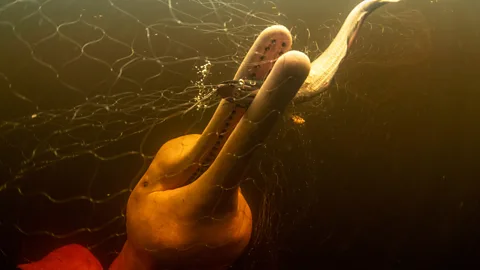
On his journey, Peschak witnessed several threats to the dolphins, including the rage of fishermen against the animals, and accidental bycatch. Even when the dolphins are not intentionally attacked, their proximity to fishermen can be risky, he says. Some animals end up hurt by the boats’ propellers, while others become entangled in the nets and drown, he adds.
“The nets are our main concern,” says marine biologist Fernando Trujillo, who has spent more than 30 years researching the South American river dolphins and accompanied Peschak on the expedition. “Every year, in a small area in Colombia alone, we have more than 700 dolphins dying because of the nets,” says Trujillo, who is a member of the Colombian Academy of Exact, Physical, and Natural Sciences.
In 1993, Trujillo founded the Omacha Foundation, a non-profit dedicated to studying and protecting the Amazon basin and its diverse species, including river dolphins. Together with other non-profits and research institutions, the Omacha Foundation is part of the South American River Dolphin Initiative (SARDI), a collaborative regional effort that promotes the conservation of these animals. Since 2017, the consortium has surveyed over 90,000 miles (144, 840km) of rivers in seven countries.
In partnership with fishermen and local communities, Trujillo’s team is conducting health assessments of river dolphins in Ecuador, Peru, Colombia and Brazil. In under 15 minutes, they capture the dolphins and move them to a wooden mat onshore, where they weigh and measure them, collect blood samples for tests, and sometimes perform ultrasound scans to check for pregnancy and tag them with GPS tracking devices.
The dolphins are the sentinels of the rivers – Fernando Trujillo
The team has found that many dolphins are contaminated with microplastics and mercury, which is used in illegal gold mining in the Amazon, Trujillo explains. In Brazil, they have seen many animals with lung problems due to the increasing fires in the rainforest, often lit by farmers to open space for cattle and plantations.
These animals, Trujillo says, are a crucial indicator of the river’s health, reflecting threats that can also be a burden to human health. Just like a canary in a coal mine, the dolphins are often the first to feel the impact of any imbalance in the rivers, such as pollution, higher water temperatures and a drop in fisheries. Likewise, if the river ecosystem is healthy, so will be the dolphins that live it. “The dolphins are the sentinels of the rivers,” he says. “Doing all these assessments, we can understand if the river is healthy or not, and what we need to do about it.”
Another imminent threat faced by the dolphins and humans alike is the changing climate. In 2023, a record-breaking drought killed over 130 pink river dolphins in Brazil. Many died because they got trapped in shallow waters that surpassed 100F (40C).
By involving locals in conservation efforts, Trujillo is attempting to create a more positive image of these creatures within the Amazonian communities, especially among fishermen. His organisation has been teaching fishermen about the importance of protecting the dolphins, training them on how to safely release and rescue entangled animals, and developing protocols on how to rescue the animals during severe droughts.

Gradually, the project is changing perceptions. “Now the fishermen have a different view,” Trujillo says. “They say, ‘Yes, dolphins are like us. They are fishermen too, sharing the same river and the same problems as us.'”
Trujillo’s team is also training locals to work as responsible dolphin watching guides, providing them with a sustainable economic alternative to fishing. They learn to keep a safe distance from the animals when bringing tourists in, while also sharing their cultural views and knowledge about these mammals.
Romani Peña Gómez, a member of the Tikuna Indigenous group in Puerto Nariño, Colombia, is trained by Omacha to conduct health surveys and work as a guide. He grew up listening to his grandmother tell stories about the river dolphins. His grandmother and other elders would perform songs and dances while wearing pink masks that mimicked their heads. “For us as indigenous people, the dolphins are the joy of the river,” Gómez says.
Gómez joined the project out of love for these mammals, aware of the violence inflicted by some fishermen, but unaware of other threats to their health. “What changed my perspective was understanding that dolphins, besides being charismatic animals, are indicators of the river’s health,” he says. “Protecting them means taking care of our own environment. They are the protectors of the rivers.”
In Brazil, researchers have also been working with fishermen, testing strategies to prevent dolphins from becoming trapped in their nets. Biologist Mariana Paschoalini Frias, coordinator of SARDI and a conservation analyst at the World Wide Fund for Nature (WWF), is using “pingers”, small, banana-shaped devices that emit high-frequency sounds underwater and can be attached to fishing nets to scare the animals away.
“Oftentimes, the fish are the only food that these families have,” says Frias. “We are trying to establish a cooperation that can benefit both the fishermen and the dolphins.”
In the Tapajós, a tributary of the Amazon River, the use of this tool has reduced the damage dolphins cause to the fishing nets by about 40%, generating an increase in catches and income for the communities, according to Frias.
Elias Correia da Silva, a 52-year-old fisherman living by the riverbanks of the Tapajós, is living proof that the effort is changing the locals’ views about the dolphins. “Before the project, we didn’t consider the dolphins our friends, and we didn’t like them because they destroyed our equipment and ate our fish,” he says. “But today we are doing our best to avoid conflict so that we can have our food and the dolphins can have theirs. This way, we can all coexist in harmony.”
Ultimately, Frias says, the future of the river dolphins depends on the collective will of the communities that share their habitat. When locals are involved and their needs addressed, they become strong allies in conservation, she says. “We can only build a sustainable future for the Amazon if we have its inhabitants leading the way.”
As for Peschak, he hopes his photos of the dolphins will help raise awareness about the state of the Amazon River and the rainforest alike. “The pink river dolphins are a fascinating flagship species,” he says. “They represent the most diverse freshwater system on our planet. So they are a very powerful storytelling tool to convince people of how fragile, important and magnificent the biodiversity of the Amazon river basin really is.”



